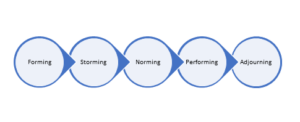#Projectmanagement #leadership #Teamdevelopment
When you start a new project in a new place it is always challenging. This could be as an employee or as a Consultant. You are presented with a new challenge, which is twofold: You have a new project to deliver and a new team to do it with.

So what is the best approach?
I want to look at 2 key things today: Team Development & Project Planning
Team Development
It doesn’t matter if the team knows each other already or not, if you have not worked with the team in that combination, you need to shape your team and pull them together. The team will need to go through the stages defined by Bruce Tuckmann:

Any time you join a team has a new leader, the older team members will try to show their prowess and also show you they are better at this than you are. There will be some storming going on. Use this as an opportunity and take note of the opinions voiced. Don’t ever try to make them shut up. Here are a few tips that have helped me in the past:
Spend some time on Team Building
The team needs to get to know each other and become comfortable with each other. This is best done in a relaxed informal way. Think of short ice breakers at the beginning of meetings and simple team building exercises. Give the team time to share about their experience and express how this can contribute to the team.
Come up with a Team Charter
A team charter is a simple document that the team develops together. It determines any pre-defined roles and the character & strength of the members. It also defines how the team wants to engage together by defining some team rules. You should also lay out how the team will deal with issues among each other.
It is a team internal document and should NEVER be shared outside.
Build Trust
You need to win the trust of the team and build trust among the team members. Trust is the basis of true team work. Team member need to be able to rely on each other and know the others have their backs.
So spend some time on helping them develop trust
Remember you are the Leader, not the Instructor
Go back to the Leadership 101, you need to enable your team, not instruct them. Sit together and make decisions together. Each team member has their unique character, set of skills experience and back ground. They can all contribute in a way that you can’t. If you try to tell them how things will be done you will miss out on so much innovation and you will destroy the team spirit.

If everyone can contribute and feels his / her opinion is valued, then they will feel appreciated and the team will pull even closer together. Come up with the project management plans together
Define Escalation & Problem Solving Paths
Define as a team internally how you will solve problems encountered within the project and how to escalate them.
Project Planning
I am sure you are guessing it already: Project planning is a team effort!

It is essential for you to enable each team member to contribute to the planning. This way you will get to tap into each team members knowledge and experience. You also help them to buy in and feel part of the project. It will be easier for them to own the processes if they were involved in planning them.
Make it a mix of team workshops, and individual preparation. You as the project manager take on a more coordinating role. All the project planning from developing the methodology over the estimation process to the final project plans is team effort.
Keep the documents and templates simple and at a minimum. Lean is the way to go. The more documents you have the less likely you are to get full compliance.
Mistakes to avoid
The worst, but very common mistake is to want to dictate to the team what is being done one and how long it will take. You are not the Subject Matter Expert, hence you do not know. Even if you have the experience, every project is different. If you dictate you will loose your teams trust and their engagement. Should you feel some time estimates are too long or too short, let it be a conversation, where you find out the thought process your team member(s) used.
If the boss or the client wants different time lines, don’t dictate them! Again make it a conversation, first with the boss & client, where you tell them that you need to discuss with the team first to see if it is possible at the quality level the work requires. Then meet with your team. Let them vent first, then discuss possible solutions. Clearly list the challenges and risks the team sees. Then come up with the best plan and best time line reasonably possible, without overstretching them. This is what you will present to the boss / client. You also explain why it will take this amount of time.
If you fall into the old trap of trying to please the boss / client by working unnecessary overtime, and overstretching the team you risk shoddy work, short cuts, unconcentrated team and the future expectation will be based on this performance. Hence in future this kind of overwork will be expected. This is the best way to loose team members
Conclusion
In a new project your leadership skills are needed. The 5 practices of exemplary Leadership are essential skills for project managers:
- Model the Way
- Inspire a shared Vision
- Challenge the Process
- Enable others to Act
- Encourage the Heart
Build meaningful relationships with each team member and get to know them. See how their individual strengths complement each other and how they add up to the team strengths.
Then keep on working on enabling your team members to bring out the best in them.
















